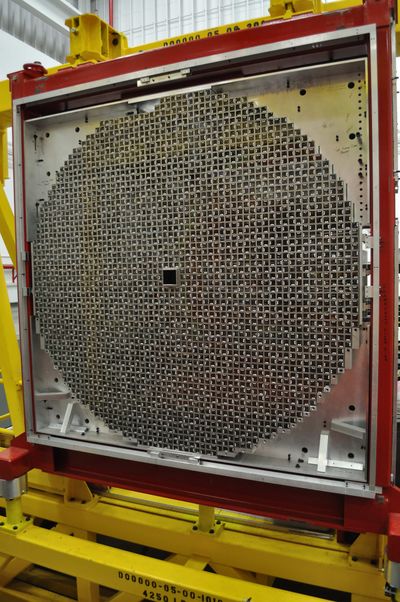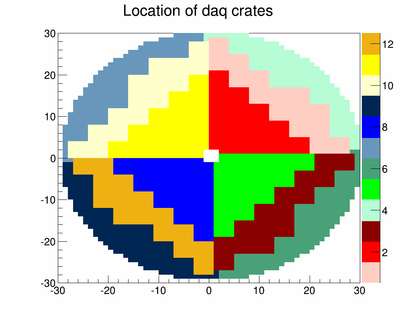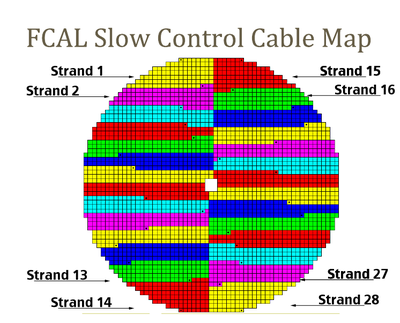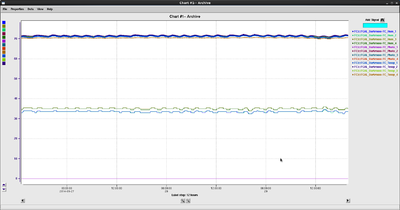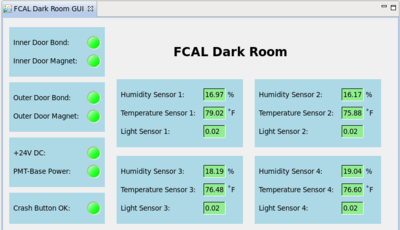Difference between revisions of "Forward Calorimeter Shift"
(→Forward Calorimeter Summary) |
|||
| Line 47: | Line 47: | ||
*FCAL Darkroom: This gives an overview of sensors monitoring the environment inside the FCAL darkroom. These should always be green unless someone is inside the darkroom.. | *FCAL Darkroom: This gives an overview of sensors monitoring the environment inside the FCAL darkroom. These should always be green unless someone is inside the darkroom.. | ||
*FCAL LED pulser: The long and short term behavior of the FCAL is monitored by an LED pulser and controlled here. This should always be running at 10 Hz and cycles between three different colors hourly. If no LED pulser appears to be going, contact an FCAL expert. Do not change anything here unless you know what you are doing! | *FCAL LED pulser: The long and short term behavior of the FCAL is monitored by an LED pulser and controlled here. This should always be running at 10 Hz and cycles between three different colors hourly. If no LED pulser appears to be going, contact an FCAL expert. Do not change anything here unless you know what you are doing! | ||
| − | *FCAL Scalars: This | + | *FCAL Scalars: This gives fADC scalar readouts from the FCAL for individual channels. |
| − | * Test Setup Voltages: Old, | + | * Test Setup Voltages: Old, can safely be ignored. |
Revision as of 14:27, 2 March 2017
Contents
Forward Calorimeter Summary
The hall D Forward Calorimeter (FCAL) is an electromagnetic calorimeter designed to detect neutrals in the forward direction from approximately 2-11 degrees in lab theta, measuring from the center of the target.
The Forward Calorimeter is a 2800 element lead glass detector consisting of 4cm x 4cm x 45cm bars. The light produced in each element is measured using FEU 84-3 PMTs. The PMTs are powered using custom Cockcroft-Walton bases and operate up to 1800 V. The entire detector exists inside an environmentally controlled and light-tight "darkroom" on the FCAL platform. Individual PMTs respond differently to a fixed voltage, so each channel has an independent voltage setting determined from a gain balancing procedure.
In general, operations that can be performed from CSS GUI windows should probably only be done by FCAL experts.
Some additional FCAL information can be found here. The page is from the commissioning era, so some information is out of date.
FCAL Elements & Mappings
- The FCAL consists of the following elements:
- FCAL Darkroom:
- 2,800 channels, each with a lead-glass block, PMT, base, and cable to read-out electronics
- 4 sets of light, temperature, and humidity monitors
- 12 Electronics Crates
- Up to 18 fADC slots per crate
- Up to 16 channel inputs per slot, signals from FCAL
- Up to 18 fADC slots per crate
- Base communication equipment:
- 7 Anagate Quattro devices that communicate with fcal bases
- 100 bases on "strand" to each anagate x 4 ports per anagate
- 1 Anagate Uno to manage quattro devices
- 4 Power Chassis: provides power to all bases for two anagates (up to 800 bases)
- 7 Anagate Quattro devices that communicate with fcal bases
- PDU equipment:
- Expert usage only
- 1 pdu to physically power cycle Anagate devices
- 1 pdu to physically power cycle Power Chassis
- FCAL Darkroom:
Routine operation
FCAL Occupancies
FCAL occupancies will likely have a small number of features to them. Single channels may have no/low occupancy. Base HV issues viewable from the FCAL HV GUI will explain some but not all channels (other problems include bad ADC readout electronics and PMT damage). Some channels may also have very high occupancy, this is likely due to abnormally large "switching noise" from the channel's base. Channels may also turn on/off in adjacent runs. Normal behavior such as any of this doesn't require notifying FCAL experts.
Other behavior (e.g. a 4x4 block going missing in occupancy plots) should be reported to FCAL experts. A typical occupancy plot from Spring '17 is shown here:
FCAL EPICS GUI Screens
- FCAL Voltages: This screen gives information on FCAL bases providing power to pmts. This gives an overview of the FCAL HV status, can be used to power channels on/off, and to navigate to individual channels. Red channels have been turned off by FCAL experts. Yellow channels indicate either voltage or communication issues. Problematic channels will most likely line up with holes in occupancy.
- FCAL Darkroom: This gives an overview of sensors monitoring the environment inside the FCAL darkroom. These should always be green unless someone is inside the darkroom..
- FCAL LED pulser: The long and short term behavior of the FCAL is monitored by an LED pulser and controlled here. This should always be running at 10 Hz and cycles between three different colors hourly. If no LED pulser appears to be going, contact an FCAL expert. Do not change anything here unless you know what you are doing!
- FCAL Scalars: This gives fADC scalar readouts from the FCAL for individual channels.
- Test Setup Voltages: Old, can safely be ignored.
FCAL Alarms
Potential FCAL alarms could come from environmental monitors inside the FCAL darkroom. However, it is not expected that we should ever reach any alarm values. The FCAL Darkroom environmental variables can be viewed using MyaViewer and selecting the group 'HD_FCAL_ROOM'
Starting Fall 2016 running, channels with base HV issues or communication issues were no longer included in EPICS alarms.
Correlating strands with FCAL coordinates
Below is slow control map where each color represents a different strand. Each strand is daisy chained to 100 bases. This view is looking upstream at the FCAL and the strands are numbered from 1 to 28. Strand 1 to 14 is only the left half of the FCAL and starts in the upper left corner and ends at the lower left corner. Strand 15 to 28 starts in the upper right corner and ends at the lower right corner.
Voltage control
The bases generate their own high voltage which can be set through the GUI interface. A non-expert user will only be able to do the following from the non-expert shift taker GUI shown in Figure 2:
- Restore HV setpoints
- Click 'SAVE/RESTORE' and select 'Restore FCAL HV Setpoints'
Below is a brief explanation of the other functionality capable on the non-expert GUI, but a shift taker must be directed by an expert to use any of the following:
- Enable HV on all bases
- Click 'All FCAL HV' and select 'Turn On All Bases'
- Disable the HV on all bases
- Can be done in 2 ways: 1) At the top of the screen there is a red outline area with 'Turn OFF ALL' written, click the 'HV' button to power off all bases, 2) click 'All FCAL HV' and select 'Turn Off All Bases'
- Save HV setpoints
- Click 'SAVE/RESTORE' and select 'Save FCAL HV Setpoints'
Interlocks
A set of "interlocks" monitor the status inside the darkroom and are set to shut off power to bases and PMTs should these exceed set limits. This is mostly done to protect PMTs from potential damage from too much ambient light. In all, there are sensors for the darkroom double doors and four sensor boxes. Each sensor box monitors temperature, humidity, and light levels.
Power supplies for the bases are interlocked and will be turned off when a) both doors to the dark room are open simultaneously, b) environmental sensors (light, temperature or humidity) in the dark room exceed preset limits or c) there is a loss of power. Should the interlock system trip, an expert should be called to reset the condition. Changes to the interlock settings are only allowed by an expert, or under his/her guidance.
Expert personnel
The individuals responsible for checking that the FCAL is ready to take data and setting its operating parameters are shown in following table. Problems with normal operation of the FCAL should be referred to those individuals and any changes to their settings must be approved by them. Additional experts may be trained by the system owner and their name and date added to this table.
| Name | Number | Date of qualification |
|---|---|---|
| Adesh Subedi | (757) 816-3649 | |
| Jon Zarling | (763) 913-6155 |
